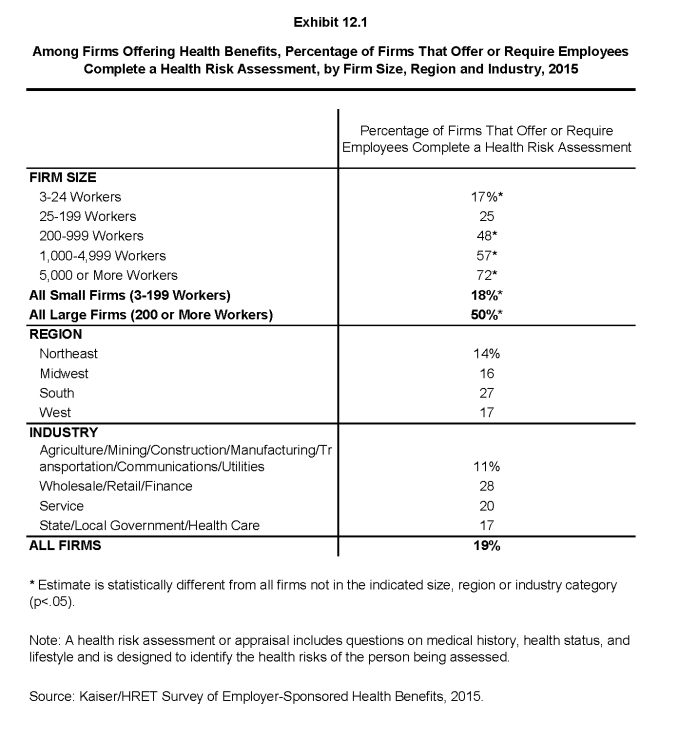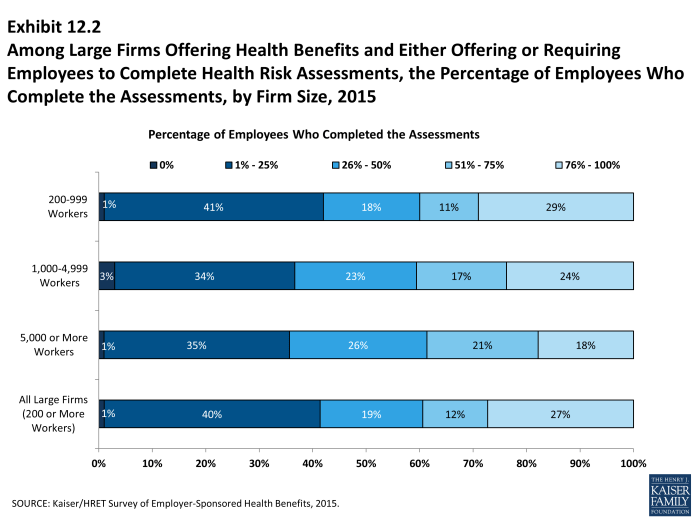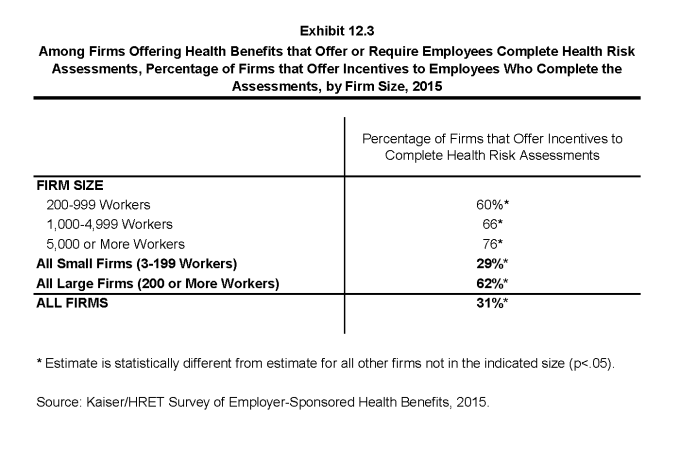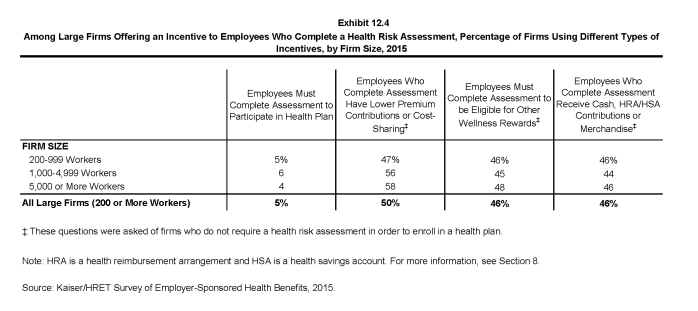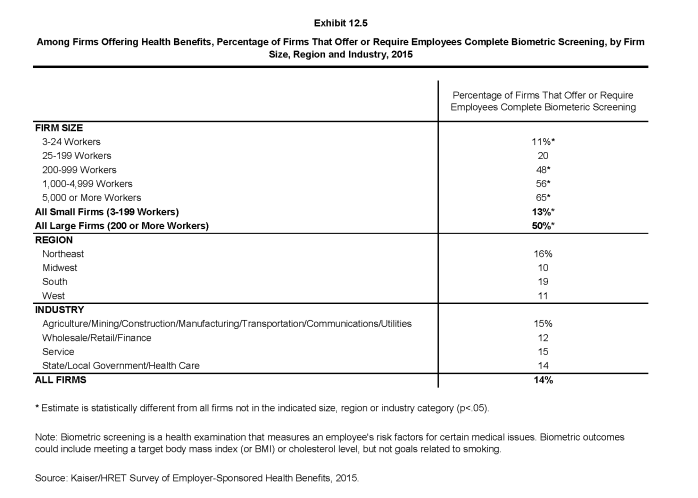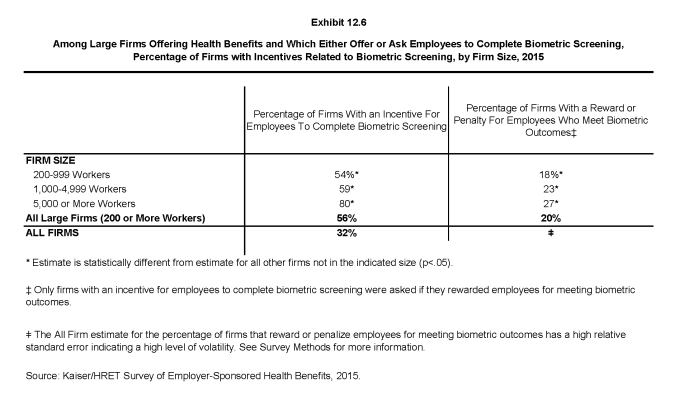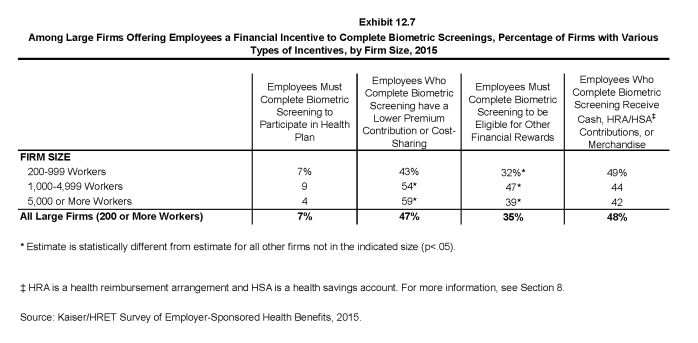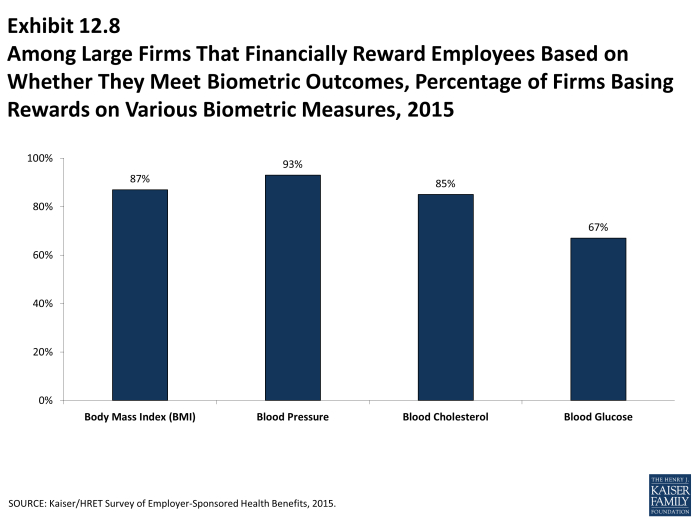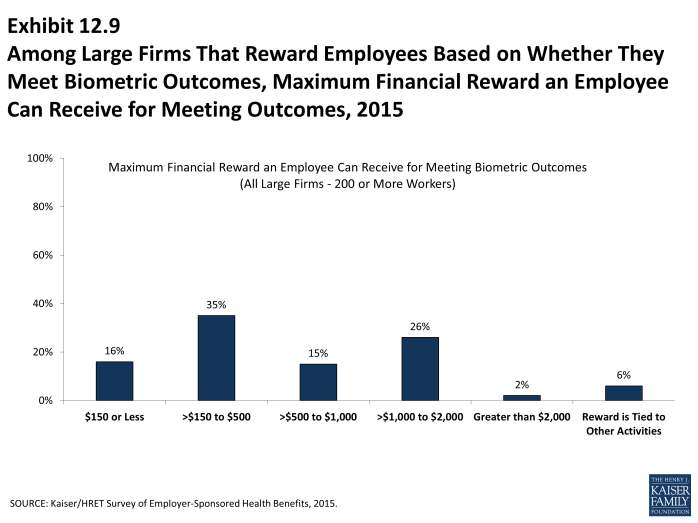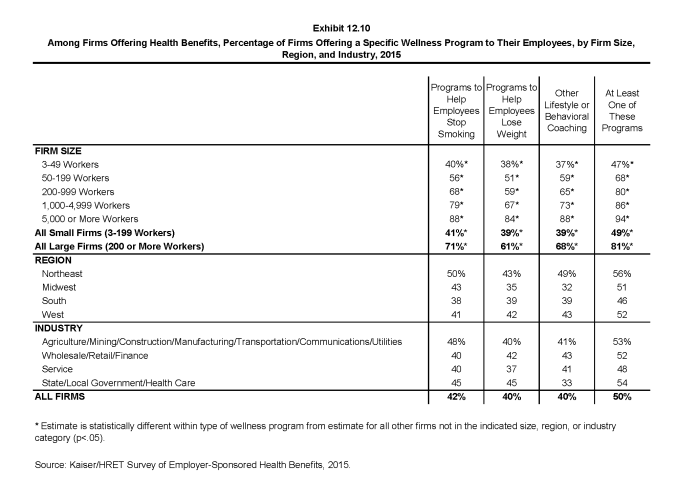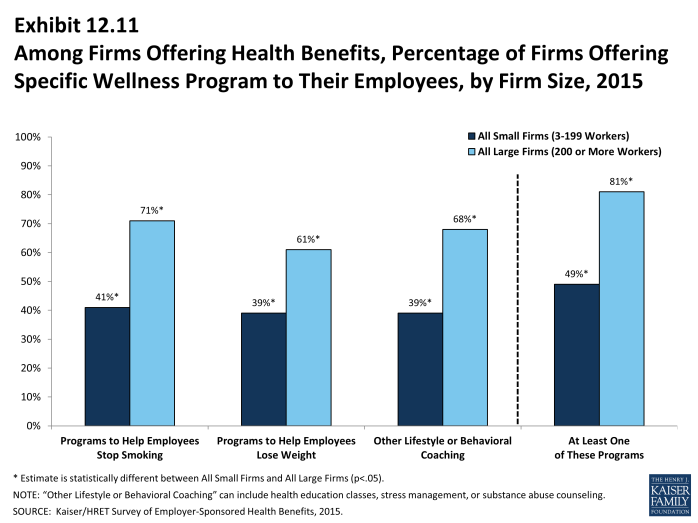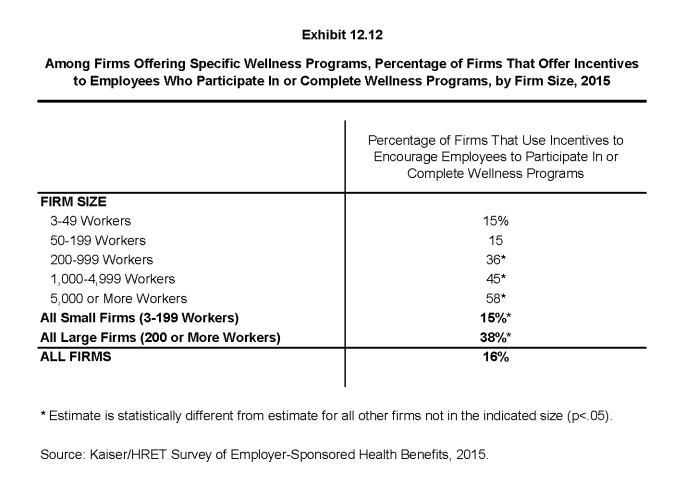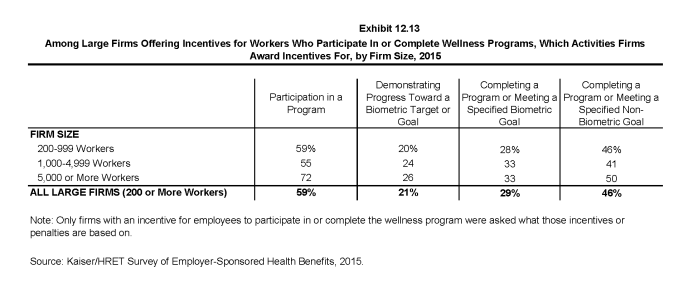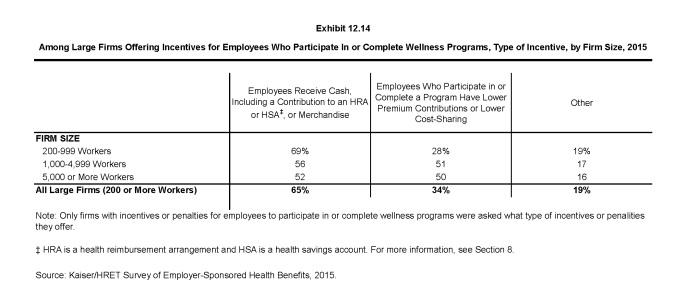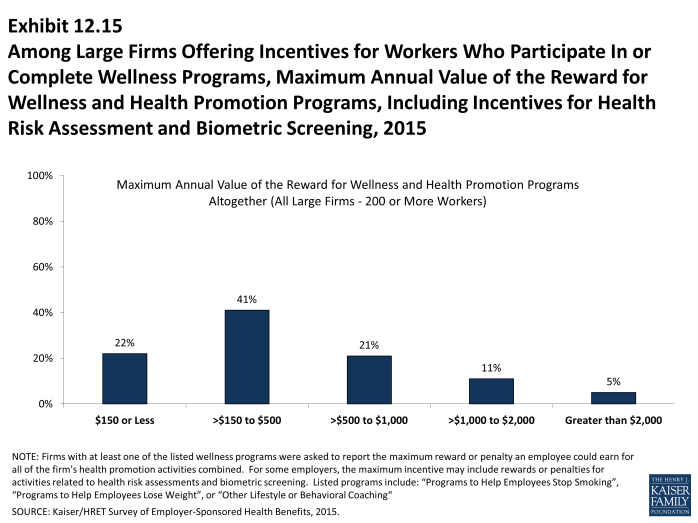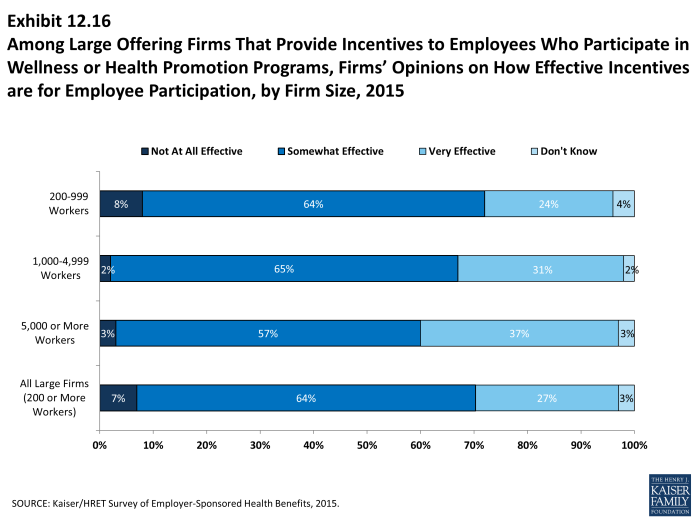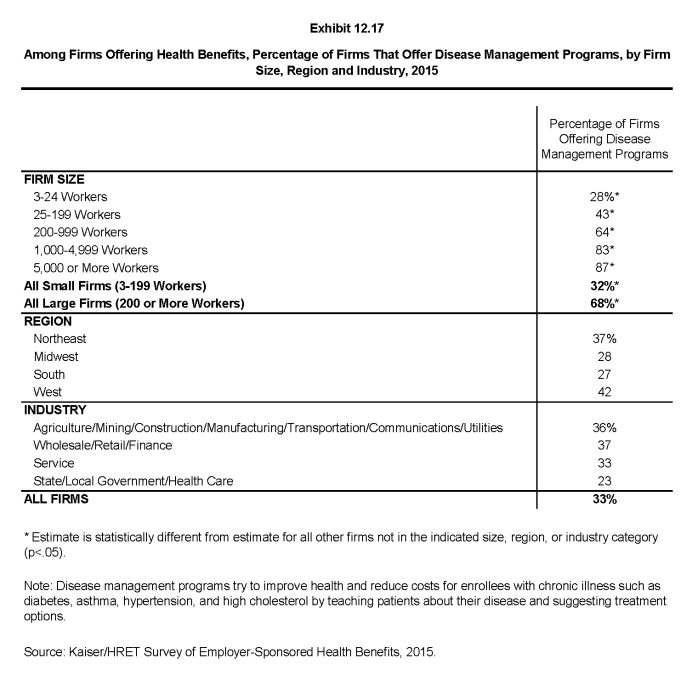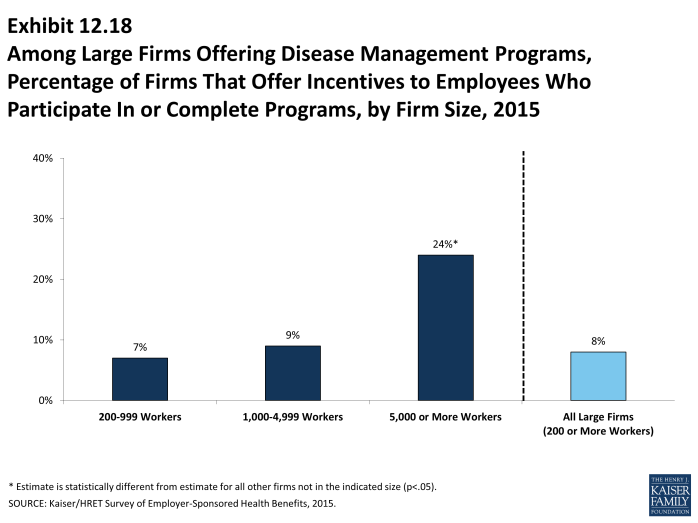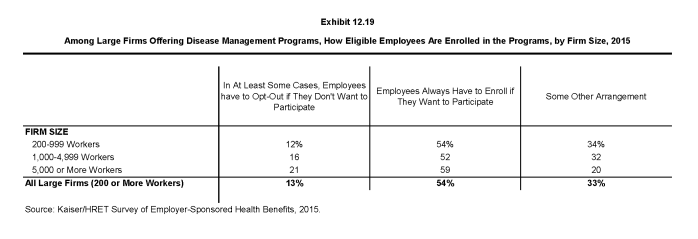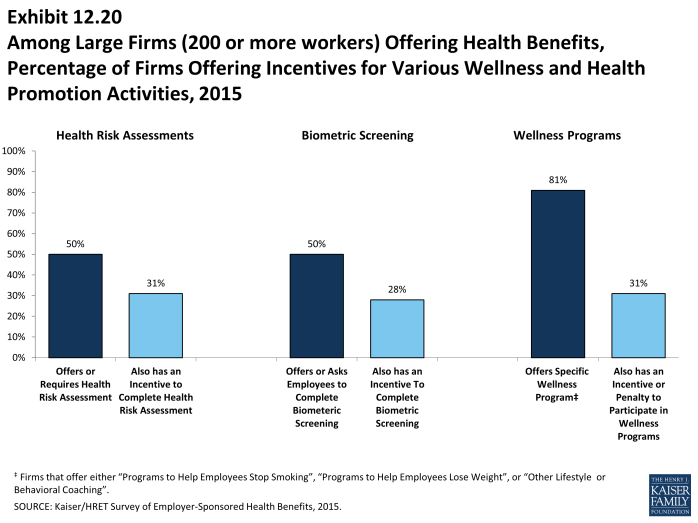2015 Employer Health Benefits Survey
Section Twelve: Health Risk Assessment, Biometrics Screening and Wellness Programs
Employers continue to show considerable interest in programs that help employees identify health issues and manage chronic conditions. Many employers believe that improving the health of their workers and their family members can improve morale, productivity and reduce health care costs. In addition to offering wellness programs, a majority of large employers now offer health screening programs including health risk assessments, which are questionnaires asking employees about lifestyle, stress or physical health, and biometric screening, which we define as in-person health examinations conducted by a medical professional. Employers and insurers may use the health information collected during screenings to target wellness offerings or other health services to employees with risk conditions. Some employers have incentive programs that reward or penalize employees for different activities, including participating in wellness programs or completing health screenings. Recent regulatory changes have expanded employers’ ability to offer incentive programs for health-contingent programs that reward employees for meeting health outcomes. We revised the 2015 survey to better capture employers’ evolving approaches to wellness programs and health screening. This year’s survey includes more information on employers’ use of incentive programs, so in most cases, statistics reported in 2015 are not comparable to previous years’ findings because of these changes. Only firms offering health benefits were asked about their wellness and health promotion programs.
In 2015, 50% of large firms (200 or more workers) offering health benefits offer the opportunity or require employees to complete health risk assessments. Fifty-percent of large employers offering health benefits offer the opportunity or ask employees to complete biometric screening. Eighty-one percent of large firms offering health benefits offer wellness programs such as programs to help employees stop smoking, programs to help employees lose weight, or other lifestyle and behavioral coaching.
Health Risk Assessments
Some firms give their employees the opportunity to complete a health risk assessment to identify potential health issues. Health risk assessments generally include questions about medical history, health status, and lifestyle.
- Overall, 19% of firms offering health benefits offer the opportunity or require employees to complete a health risk assessment. Large firms (200 or more workers) are more likely than small firms to offer or require employees to complete the assessment (50% vs. 18%). Among offering firms with 5,000 or more employees, 72% either offer or require employees to complete a health risk assessment (Exhibit 12.1).
- The percentage of large firms (200 or more workers) who offer their employees the opportunity to complete a health risk assessment (50%) is similar to last year (51%).
- Some firms offer financial incentives to encourage employees to complete health risk assessments.
- Among firms that offer health benefits and a health risk assessment, 31% offer an incentive to employees who complete the assessment. Large firms (200 or more workers) that offer health risk assessments are more likely to offer a financial incentive than small firms (62% vs. 29%) (Exhibit 12.3).
- Half (50%) of large employers that offer health risk assessments offer employees who complete the assessment lower premium contributions or reduced cost sharing. Five percent of large firms (200 or more workers) that offer health risk assessments report that they require employees to complete a health risk assessment in order to enroll in a health plan (Exhibit 12.4). Some employers with incentives to complete health risk assessments may offer employees multiple types of incentives.
- About half of the employees (51% in small firms (3-199 workers) and 45% in large firms) who are offered the opportunity or required to complete a health risk assessment actually do so (Exhibit 12.2).
- There is considerable variation in the percentage of workers who complete the screening. Twenty-seven percent of large firms (200 or more workers) offering or requiring a health risk assessment report that more than 75% of their employees complete the assessment, while 41% report no more than 25% of employees complete the assessment (Exhibit 12.2).
Biometric Screening
Biometric screening is a health examination that measures an employee’s risk factors for certain medical issues such as cholesterol, blood pressure, stress, and nutrition. Biometric outcomes may include meeting a target body mass index (BMI) or cholesterol level. As defined by this survey, goals related to smoking are not included.
- Thirteen percent of small firms (3 to 199 workers) and 50% of large firms offering health benefits offer employees the opportunity or ask employees to complete biometric screenings. Among firms with 5,000 or more workers, 65% of firms offering health benefits have biometric screening programs (Exhibit 12.5).
- Firms that offer or ask employees to complete biometric screenings may include additional incentives for those employees who do so. Thirty-two percent of firms with biometric screening programs offer an incentive for employees to complete the screening. Firms with 5,000 or more employees with biometric screening programs are more likely to have an incentive to complete the screening (80%) than firms in other size categories (Exhibit 12.6).
- Among large firms (200 or more workers) with biometric screening programs that offer an incentive to complete biometric screenings, 7% require employees to complete screenings in order to enroll in a health plan.
- Forty-seven percent of large employers (200 or more workers) with biometric screening programs that offer an incentive to complete biometric screenings offer employees who complete biometric screenings lower premium contributions or lower cost sharing (Exhibit 12.7).
- Among large firms (200 or more workers) offering biometric screenings and an incentive for completing the screening, 20% reward or penalize employees for meeting biometric outcomes (Exhibit 12.6). The Affordable Care Act allowed employers to increase the size of their financial incentives for completing health-contingent wellness programs, which can include meeting biometric targets.
- Among firms that reward or penalize employees for meeting biometric outcomes, 93% include targets for blood pressure, 87% include targets for BMI, and 85% include targets for blood cholesterol (Exhibit 12.8).
- There is considerable variation in the size of the incentives that employers offer for meeting biometric outcomes. Among large firms (200 or more workers) offering a reward or penalty for meeting biometric outcomes, the maximum reward is valued at a $150 dollars or less for 16% percent of firms and $1,000 or more for 28% of firms (Exhibit 12.9).
Wellness Programs
For a variety of reasons including efforts to improve health and lower costs, many employers and health plans offer wellness programs. Wellness programs may include exercise programs, health education classes, and stress-management counseling. Wellness programs may be offered directly by the firm, an insurer, or a third-party contractor.
- Seventy-one percent of large firms (200 or more workers) offering health benefits offer programs to help employees stop smoking, 68% offer lifestyle or behavioral coaching, and 61% offer programs to help employees lose weight. Eighty-one percent of large employers offering health benefits report offering at least one of these three programs (Exhibit 12.10).
- Large firms (200 or more workers) offering health benefits are more likely to offer each of the listed wellness programs than small firms (3-199 workers) (Exhibit 12.11).
- To encourage participation in wellness programs, firms may offer financial incentives to employees who participate in or complete wellness programs.
- Sixteen percent of firms offering wellness benefits offer an incentive to encourage employees to participate in or complete wellness programs. Large firms offering wellness programs are more likely to offer an incentive than small firms (38% vs. 15%). Over half (58%) of firms with more than 5,000 employees who offer a wellness program offer an incentive to participate in or complete wellness programs (Exhibit 12.12).
- Sixty-five percent of large firms (200 or more workers) with an incentive for workers to participate in or complete wellness programs offer cash (including a contribution to an HRA or HSA) or merchandise for participating in or completing a wellness program. Thirty-four percent of those firms offer lower premium contributions or cost sharing, and 19% offer some other type of incentive (Exhibit 12.14).
- Fifty-nine percent of large firms (200 or more workers) that offer an incentive for wellness programs offered incentives based on whether employees participated in the program (Exhibit 12.13).
- Firms with at least one of the listed wellness programs were asked to report the maximum reward or penalty an employee could earn for all of the firm’s health promotion activities combined. For some employers, the maximum incentive may include rewards or penalties for activities related to health risk assessments and biometric screening. Some employers do not offer incentives for individual activities, but offer rewards to employees who complete a variety of activities. Among large firms offering incentives for wellness or health promotion programs, 22% reported that the maximum value of all their incentives for health risk assessments, biometric screenings, and wellness programs combined is $150 or less. Fifteen percent of these employers indicate that the maximum reward is more than $1,000 (Exhibit 12.15).
- Firms that offer an incentive for employees to participate in or complete wellness or health promotion programs were asked how effective they believed incentives were for encouraging participation. Twenty-seven percent of large firms offering health benefits and incentives to participate in wellness or health promotion programs think incentives are “very effective” at encouraging employees to participate (Exhibit 12.16).
Disease Management
Disease management programs try to improve health and reduce costs for enrollees with chronic illness by teaching patients about their disease and suggesting treatment options. These programs can help employees with conditions such as diabetes, asthma, hypertension, and high cholesterol.
- Thirty-three percent of firms that offer health benefits offer disease management programs. Large firms (200 or more workers) are more likely than small firms to offer disease management programs (68% vs. 32%) (Exhibit 12.17).
- Eight percent of large firms that offer disease management programs offer incentives to employees who participate in or complete the programs. This percentage is highest among firms with 5,000 or more workers (24%) (Exhibit 12.18).
- Firms that offer disease management programs have different methods for enrolling eligible employees. In 54% of large firms offering disease management programs, employees have to enroll if they want to participate. In 13% of these firms, in at least some cases, employees have to opt-out if they do not want to participate (Exhibit 12.19)

